Creating a Comprehensive Reading Resource for ELA200
VerifiedAdded on 2022/08/16
|15
|3250
|26
Project
AI Summary
This project presents a comprehensive reading resource developed for the ELA200 course, focusing on teaching reading skills within the Australian Curriculum framework. The resource encompasses a detailed teaching sequence comprised of five lesson plans designed to integrate effective pedagogical approaches. The assignment includes a thorough description of the teaching and learning context, justification of the pedagogical strategies employed, and principles of lesson sequence design. The content also features a selection of appropriate tasks, activities, and resources aimed at supporting students in their reading development. Furthermore, the project incorporates an assessment, moderation, and reporting plan, complete with timely feedback strategies to monitor student progress and enhance learning outcomes. The resource emphasizes comprehension strategies, vocabulary instruction, and the development of critical thinking skills. It aligns with the Australian Curriculum's focus on language, literacy, and literature, promoting students' abilities in listening, reading, speaking, writing, and creating. The resource is designed to be adaptable and effective for diverse learners, incorporating visual media, building blocks, and a variety of text genres. The project also includes a reflection on the pedagogical approaches used, such as integrative, reflective, constructivist, collaborative, and inquiry-based methods, to enhance the learning experience.
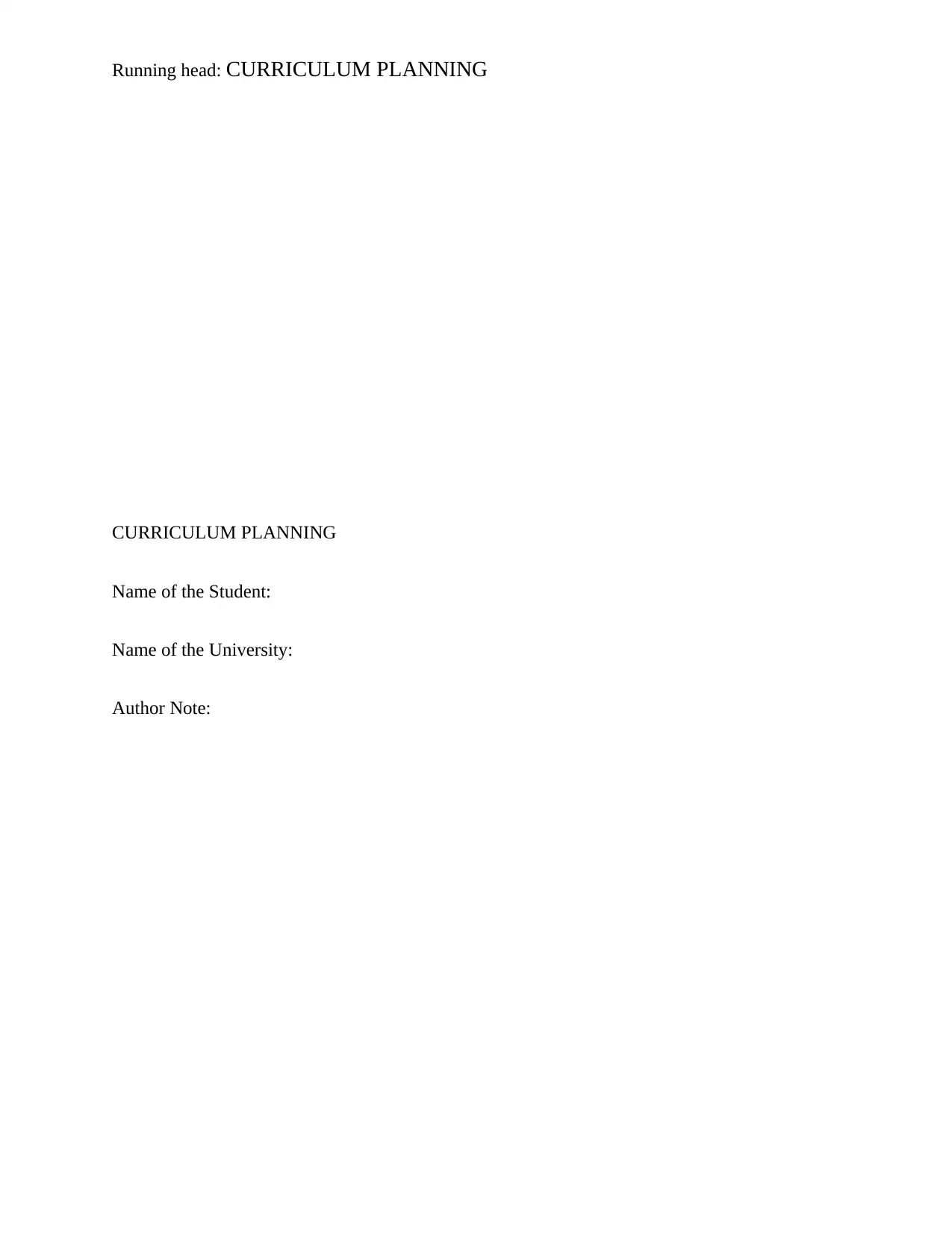
Running head: CURRICULUM PLANNING
CURRICULUM PLANNING
Name of the Student:
Name of the University:
Author Note:
CURRICULUM PLANNING
Name of the Student:
Name of the University:
Author Note:
Paraphrase This Document
Need a fresh take? Get an instant paraphrase of this document with our AI Paraphraser
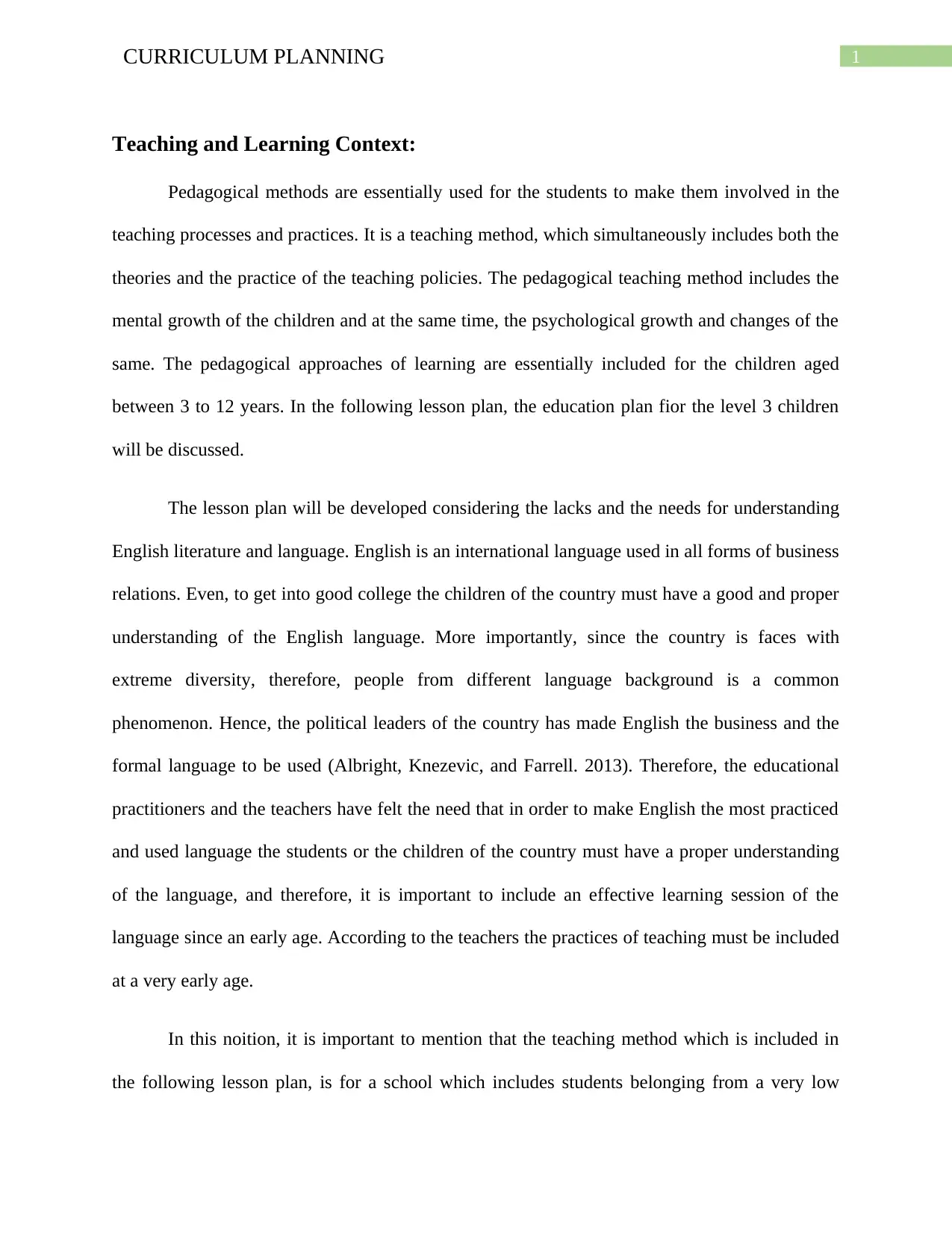
1CURRICULUM PLANNING
Teaching and Learning Context:
Pedagogical methods are essentially used for the students to make them involved in the
teaching processes and practices. It is a teaching method, which simultaneously includes both the
theories and the practice of the teaching policies. The pedagogical teaching method includes the
mental growth of the children and at the same time, the psychological growth and changes of the
same. The pedagogical approaches of learning are essentially included for the children aged
between 3 to 12 years. In the following lesson plan, the education plan fior the level 3 children
will be discussed.
The lesson plan will be developed considering the lacks and the needs for understanding
English literature and language. English is an international language used in all forms of business
relations. Even, to get into good college the children of the country must have a good and proper
understanding of the English language. More importantly, since the country is faces with
extreme diversity, therefore, people from different language background is a common
phenomenon. Hence, the political leaders of the country has made English the business and the
formal language to be used (Albright, Knezevic, and Farrell. 2013). Therefore, the educational
practitioners and the teachers have felt the need that in order to make English the most practiced
and used language the students or the children of the country must have a proper understanding
of the language, and therefore, it is important to include an effective learning session of the
language since an early age. According to the teachers the practices of teaching must be included
at a very early age.
In this noition, it is important to mention that the teaching method which is included in
the following lesson plan, is for a school which includes students belonging from a very low
Teaching and Learning Context:
Pedagogical methods are essentially used for the students to make them involved in the
teaching processes and practices. It is a teaching method, which simultaneously includes both the
theories and the practice of the teaching policies. The pedagogical teaching method includes the
mental growth of the children and at the same time, the psychological growth and changes of the
same. The pedagogical approaches of learning are essentially included for the children aged
between 3 to 12 years. In the following lesson plan, the education plan fior the level 3 children
will be discussed.
The lesson plan will be developed considering the lacks and the needs for understanding
English literature and language. English is an international language used in all forms of business
relations. Even, to get into good college the children of the country must have a good and proper
understanding of the English language. More importantly, since the country is faces with
extreme diversity, therefore, people from different language background is a common
phenomenon. Hence, the political leaders of the country has made English the business and the
formal language to be used (Albright, Knezevic, and Farrell. 2013). Therefore, the educational
practitioners and the teachers have felt the need that in order to make English the most practiced
and used language the students or the children of the country must have a proper understanding
of the language, and therefore, it is important to include an effective learning session of the
language since an early age. According to the teachers the practices of teaching must be included
at a very early age.
In this noition, it is important to mention that the teaching method which is included in
the following lesson plan, is for a school which includes students belonging from a very low
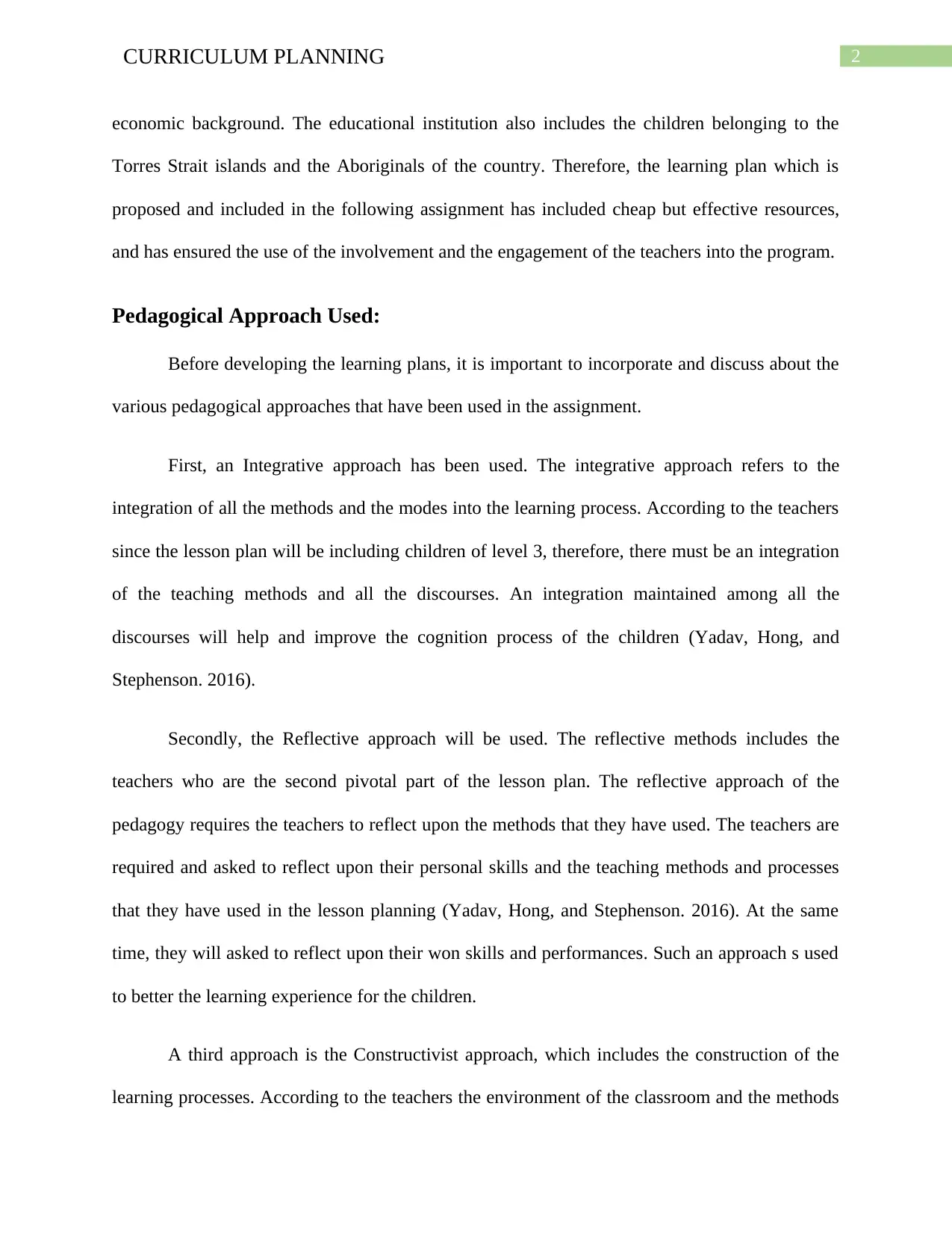
2CURRICULUM PLANNING
economic background. The educational institution also includes the children belonging to the
Torres Strait islands and the Aboriginals of the country. Therefore, the learning plan which is
proposed and included in the following assignment has included cheap but effective resources,
and has ensured the use of the involvement and the engagement of the teachers into the program.
Pedagogical Approach Used:
Before developing the learning plans, it is important to incorporate and discuss about the
various pedagogical approaches that have been used in the assignment.
First, an Integrative approach has been used. The integrative approach refers to the
integration of all the methods and the modes into the learning process. According to the teachers
since the lesson plan will be including children of level 3, therefore, there must be an integration
of the teaching methods and all the discourses. An integration maintained among all the
discourses will help and improve the cognition process of the children (Yadav, Hong, and
Stephenson. 2016).
Secondly, the Reflective approach will be used. The reflective methods includes the
teachers who are the second pivotal part of the lesson plan. The reflective approach of the
pedagogy requires the teachers to reflect upon the methods that they have used. The teachers are
required and asked to reflect upon their personal skills and the teaching methods and processes
that they have used in the lesson planning (Yadav, Hong, and Stephenson. 2016). At the same
time, they will asked to reflect upon their won skills and performances. Such an approach s used
to better the learning experience for the children.
A third approach is the Constructivist approach, which includes the construction of the
learning processes. According to the teachers the environment of the classroom and the methods
economic background. The educational institution also includes the children belonging to the
Torres Strait islands and the Aboriginals of the country. Therefore, the learning plan which is
proposed and included in the following assignment has included cheap but effective resources,
and has ensured the use of the involvement and the engagement of the teachers into the program.
Pedagogical Approach Used:
Before developing the learning plans, it is important to incorporate and discuss about the
various pedagogical approaches that have been used in the assignment.
First, an Integrative approach has been used. The integrative approach refers to the
integration of all the methods and the modes into the learning process. According to the teachers
since the lesson plan will be including children of level 3, therefore, there must be an integration
of the teaching methods and all the discourses. An integration maintained among all the
discourses will help and improve the cognition process of the children (Yadav, Hong, and
Stephenson. 2016).
Secondly, the Reflective approach will be used. The reflective methods includes the
teachers who are the second pivotal part of the lesson plan. The reflective approach of the
pedagogy requires the teachers to reflect upon the methods that they have used. The teachers are
required and asked to reflect upon their personal skills and the teaching methods and processes
that they have used in the lesson planning (Yadav, Hong, and Stephenson. 2016). At the same
time, they will asked to reflect upon their won skills and performances. Such an approach s used
to better the learning experience for the children.
A third approach is the Constructivist approach, which includes the construction of the
learning processes. According to the teachers the environment of the classroom and the methods
⊘ This is a preview!⊘
Do you want full access?
Subscribe today to unlock all pages.

Trusted by 1+ million students worldwide
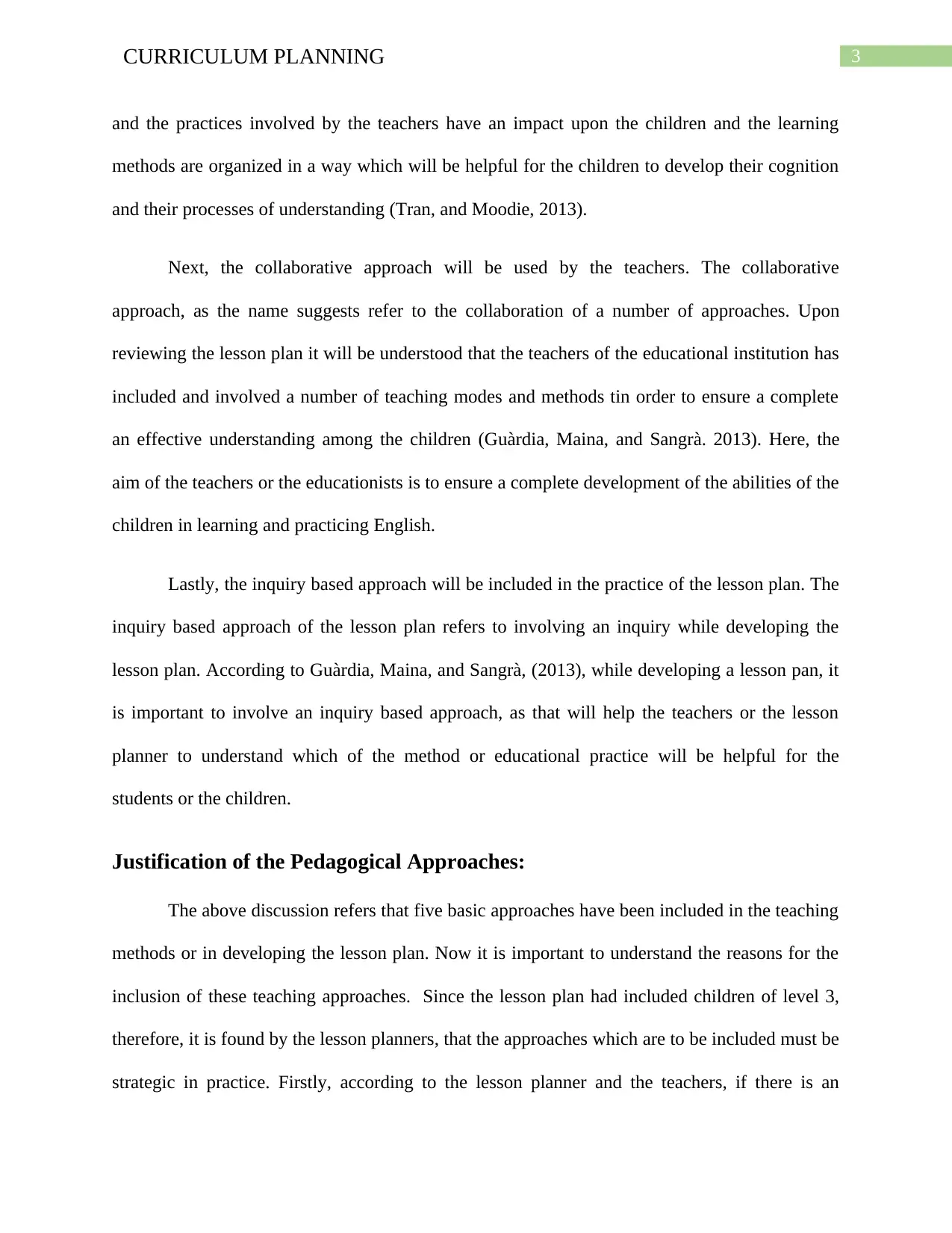
3CURRICULUM PLANNING
and the practices involved by the teachers have an impact upon the children and the learning
methods are organized in a way which will be helpful for the children to develop their cognition
and their processes of understanding (Tran, and Moodie, 2013).
Next, the collaborative approach will be used by the teachers. The collaborative
approach, as the name suggests refer to the collaboration of a number of approaches. Upon
reviewing the lesson plan it will be understood that the teachers of the educational institution has
included and involved a number of teaching modes and methods tin order to ensure a complete
an effective understanding among the children (Guàrdia, Maina, and Sangrà. 2013). Here, the
aim of the teachers or the educationists is to ensure a complete development of the abilities of the
children in learning and practicing English.
Lastly, the inquiry based approach will be included in the practice of the lesson plan. The
inquiry based approach of the lesson plan refers to involving an inquiry while developing the
lesson plan. According to Guàrdia, Maina, and Sangrà, (2013), while developing a lesson pan, it
is important to involve an inquiry based approach, as that will help the teachers or the lesson
planner to understand which of the method or educational practice will be helpful for the
students or the children.
Justification of the Pedagogical Approaches:
The above discussion refers that five basic approaches have been included in the teaching
methods or in developing the lesson plan. Now it is important to understand the reasons for the
inclusion of these teaching approaches. Since the lesson plan had included children of level 3,
therefore, it is found by the lesson planners, that the approaches which are to be included must be
strategic in practice. Firstly, according to the lesson planner and the teachers, if there is an
and the practices involved by the teachers have an impact upon the children and the learning
methods are organized in a way which will be helpful for the children to develop their cognition
and their processes of understanding (Tran, and Moodie, 2013).
Next, the collaborative approach will be used by the teachers. The collaborative
approach, as the name suggests refer to the collaboration of a number of approaches. Upon
reviewing the lesson plan it will be understood that the teachers of the educational institution has
included and involved a number of teaching modes and methods tin order to ensure a complete
an effective understanding among the children (Guàrdia, Maina, and Sangrà. 2013). Here, the
aim of the teachers or the educationists is to ensure a complete development of the abilities of the
children in learning and practicing English.
Lastly, the inquiry based approach will be included in the practice of the lesson plan. The
inquiry based approach of the lesson plan refers to involving an inquiry while developing the
lesson plan. According to Guàrdia, Maina, and Sangrà, (2013), while developing a lesson pan, it
is important to involve an inquiry based approach, as that will help the teachers or the lesson
planner to understand which of the method or educational practice will be helpful for the
students or the children.
Justification of the Pedagogical Approaches:
The above discussion refers that five basic approaches have been included in the teaching
methods or in developing the lesson plan. Now it is important to understand the reasons for the
inclusion of these teaching approaches. Since the lesson plan had included children of level 3,
therefore, it is found by the lesson planners, that the approaches which are to be included must be
strategic in practice. Firstly, according to the lesson planner and the teachers, if there is an
Paraphrase This Document
Need a fresh take? Get an instant paraphrase of this document with our AI Paraphraser
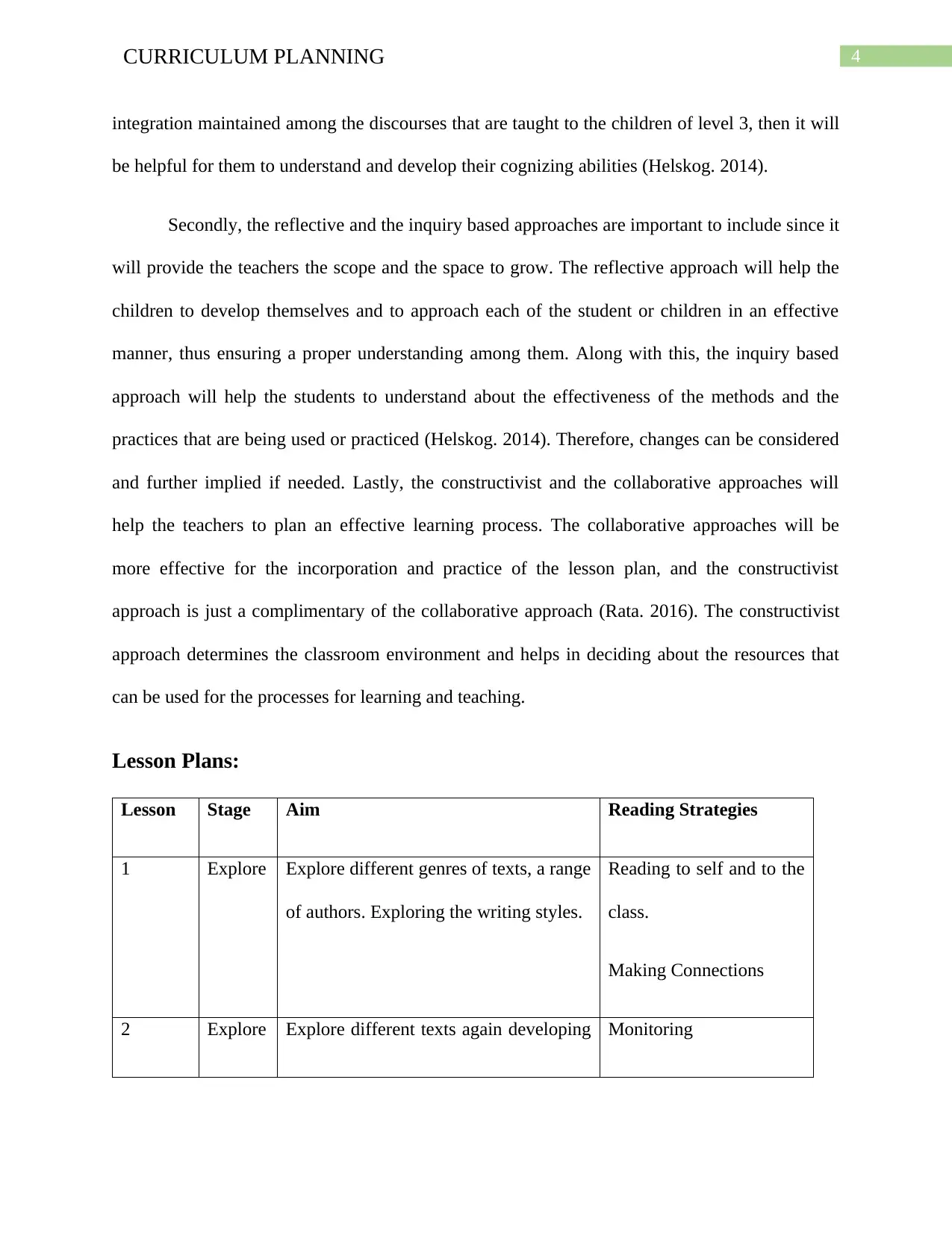
4CURRICULUM PLANNING
integration maintained among the discourses that are taught to the children of level 3, then it will
be helpful for them to understand and develop their cognizing abilities (Helskog. 2014).
Secondly, the reflective and the inquiry based approaches are important to include since it
will provide the teachers the scope and the space to grow. The reflective approach will help the
children to develop themselves and to approach each of the student or children in an effective
manner, thus ensuring a proper understanding among them. Along with this, the inquiry based
approach will help the students to understand about the effectiveness of the methods and the
practices that are being used or practiced (Helskog. 2014). Therefore, changes can be considered
and further implied if needed. Lastly, the constructivist and the collaborative approaches will
help the teachers to plan an effective learning process. The collaborative approaches will be
more effective for the incorporation and practice of the lesson plan, and the constructivist
approach is just a complimentary of the collaborative approach (Rata. 2016). The constructivist
approach determines the classroom environment and helps in deciding about the resources that
can be used for the processes for learning and teaching.
Lesson Plans:
Lesson Stage Aim Reading Strategies
1 Explore Explore different genres of texts, a range
of authors. Exploring the writing styles.
Reading to self and to the
class.
Making Connections
2 Explore Explore different texts again developing Monitoring
integration maintained among the discourses that are taught to the children of level 3, then it will
be helpful for them to understand and develop their cognizing abilities (Helskog. 2014).
Secondly, the reflective and the inquiry based approaches are important to include since it
will provide the teachers the scope and the space to grow. The reflective approach will help the
children to develop themselves and to approach each of the student or children in an effective
manner, thus ensuring a proper understanding among them. Along with this, the inquiry based
approach will help the students to understand about the effectiveness of the methods and the
practices that are being used or practiced (Helskog. 2014). Therefore, changes can be considered
and further implied if needed. Lastly, the constructivist and the collaborative approaches will
help the teachers to plan an effective learning process. The collaborative approaches will be
more effective for the incorporation and practice of the lesson plan, and the constructivist
approach is just a complimentary of the collaborative approach (Rata. 2016). The constructivist
approach determines the classroom environment and helps in deciding about the resources that
can be used for the processes for learning and teaching.
Lesson Plans:
Lesson Stage Aim Reading Strategies
1 Explore Explore different genres of texts, a range
of authors. Exploring the writing styles.
Reading to self and to the
class.
Making Connections
2 Explore Explore different texts again developing Monitoring
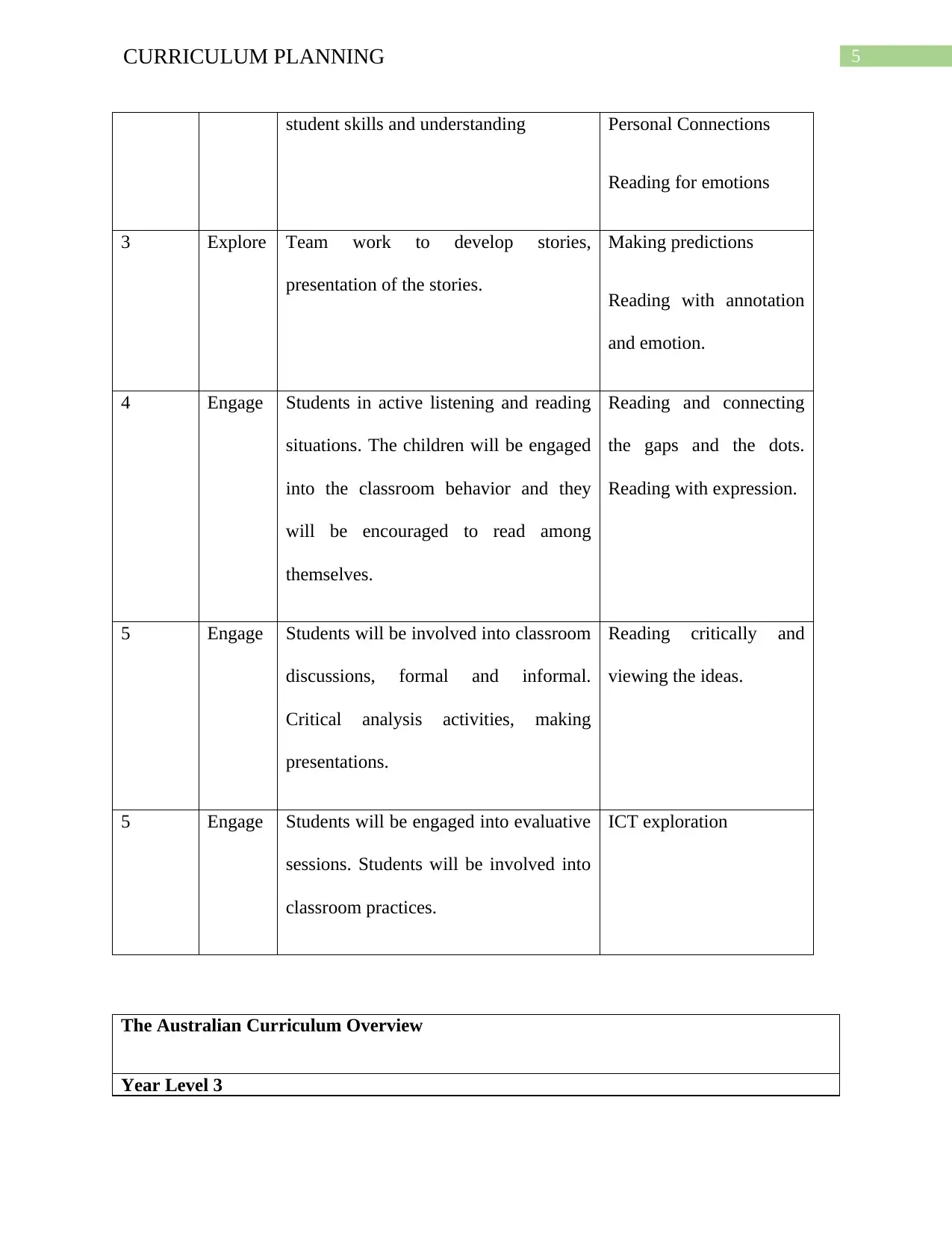
5CURRICULUM PLANNING
student skills and understanding Personal Connections
Reading for emotions
3 Explore Team work to develop stories,
presentation of the stories.
Making predictions
Reading with annotation
and emotion.
4 Engage Students in active listening and reading
situations. The children will be engaged
into the classroom behavior and they
will be encouraged to read among
themselves.
Reading and connecting
the gaps and the dots.
Reading with expression.
5 Engage Students will be involved into classroom
discussions, formal and informal.
Critical analysis activities, making
presentations.
Reading critically and
viewing the ideas.
5 Engage Students will be engaged into evaluative
sessions. Students will be involved into
classroom practices.
ICT exploration
The Australian Curriculum Overview
Year Level 3
student skills and understanding Personal Connections
Reading for emotions
3 Explore Team work to develop stories,
presentation of the stories.
Making predictions
Reading with annotation
and emotion.
4 Engage Students in active listening and reading
situations. The children will be engaged
into the classroom behavior and they
will be encouraged to read among
themselves.
Reading and connecting
the gaps and the dots.
Reading with expression.
5 Engage Students will be involved into classroom
discussions, formal and informal.
Critical analysis activities, making
presentations.
Reading critically and
viewing the ideas.
5 Engage Students will be engaged into evaluative
sessions. Students will be involved into
classroom practices.
ICT exploration
The Australian Curriculum Overview
Year Level 3
⊘ This is a preview!⊘
Do you want full access?
Subscribe today to unlock all pages.

Trusted by 1+ million students worldwide
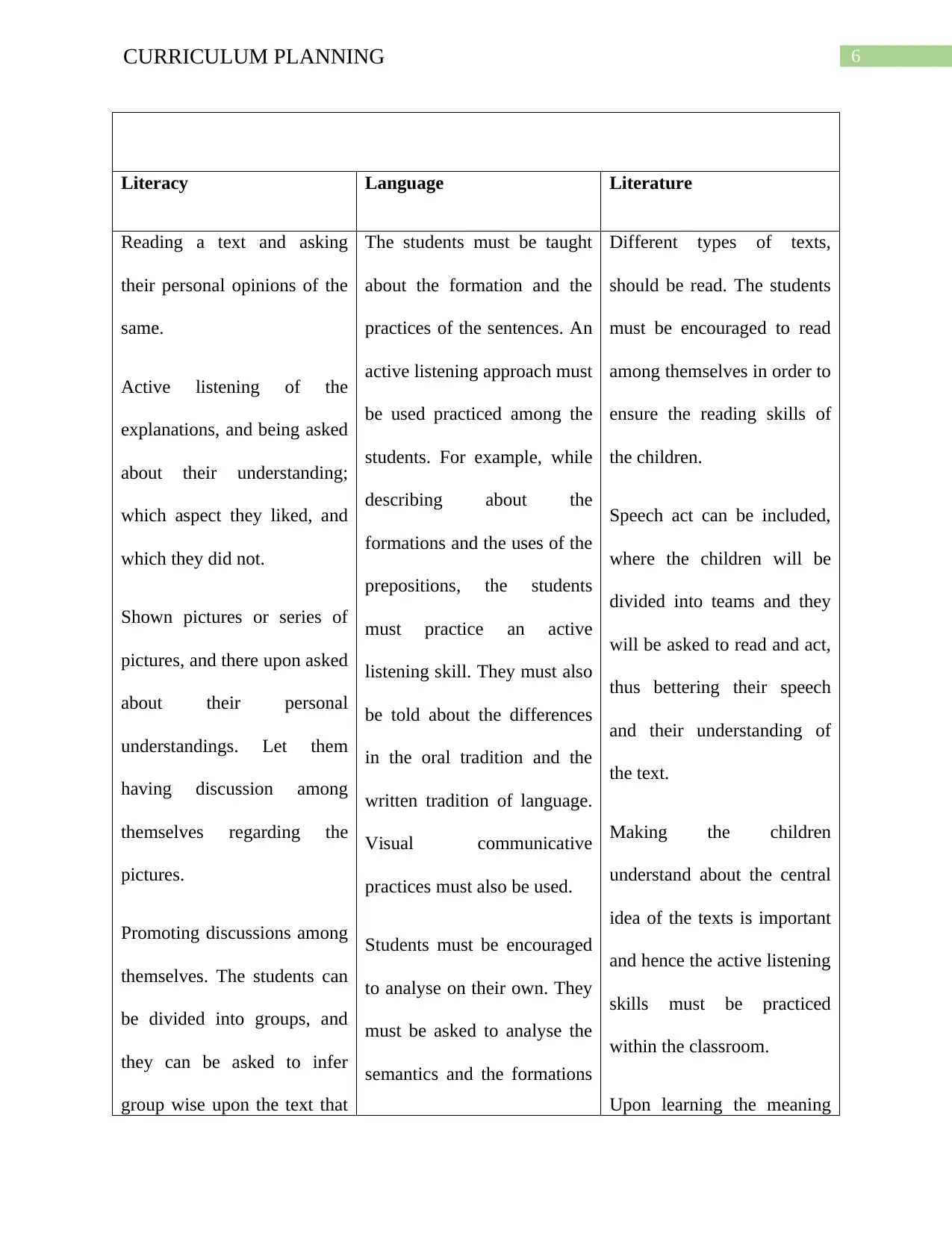
6CURRICULUM PLANNING
Literacy Language Literature
Reading a text and asking
their personal opinions of the
same.
Active listening of the
explanations, and being asked
about their understanding;
which aspect they liked, and
which they did not.
Shown pictures or series of
pictures, and there upon asked
about their personal
understandings. Let them
having discussion among
themselves regarding the
pictures.
Promoting discussions among
themselves. The students can
be divided into groups, and
they can be asked to infer
group wise upon the text that
The students must be taught
about the formation and the
practices of the sentences. An
active listening approach must
be used practiced among the
students. For example, while
describing about the
formations and the uses of the
prepositions, the students
must practice an active
listening skill. They must also
be told about the differences
in the oral tradition and the
written tradition of language.
Visual communicative
practices must also be used.
Students must be encouraged
to analyse on their own. They
must be asked to analyse the
semantics and the formations
Different types of texts,
should be read. The students
must be encouraged to read
among themselves in order to
ensure the reading skills of
the children.
Speech act can be included,
where the children will be
divided into teams and they
will be asked to read and act,
thus bettering their speech
and their understanding of
the text.
Making the children
understand about the central
idea of the texts is important
and hence the active listening
skills must be practiced
within the classroom.
Upon learning the meaning
Literacy Language Literature
Reading a text and asking
their personal opinions of the
same.
Active listening of the
explanations, and being asked
about their understanding;
which aspect they liked, and
which they did not.
Shown pictures or series of
pictures, and there upon asked
about their personal
understandings. Let them
having discussion among
themselves regarding the
pictures.
Promoting discussions among
themselves. The students can
be divided into groups, and
they can be asked to infer
group wise upon the text that
The students must be taught
about the formation and the
practices of the sentences. An
active listening approach must
be used practiced among the
students. For example, while
describing about the
formations and the uses of the
prepositions, the students
must practice an active
listening skill. They must also
be told about the differences
in the oral tradition and the
written tradition of language.
Visual communicative
practices must also be used.
Students must be encouraged
to analyse on their own. They
must be asked to analyse the
semantics and the formations
Different types of texts,
should be read. The students
must be encouraged to read
among themselves in order to
ensure the reading skills of
the children.
Speech act can be included,
where the children will be
divided into teams and they
will be asked to read and act,
thus bettering their speech
and their understanding of
the text.
Making the children
understand about the central
idea of the texts is important
and hence the active listening
skills must be practiced
within the classroom.
Upon learning the meaning
Paraphrase This Document
Need a fresh take? Get an instant paraphrase of this document with our AI Paraphraser
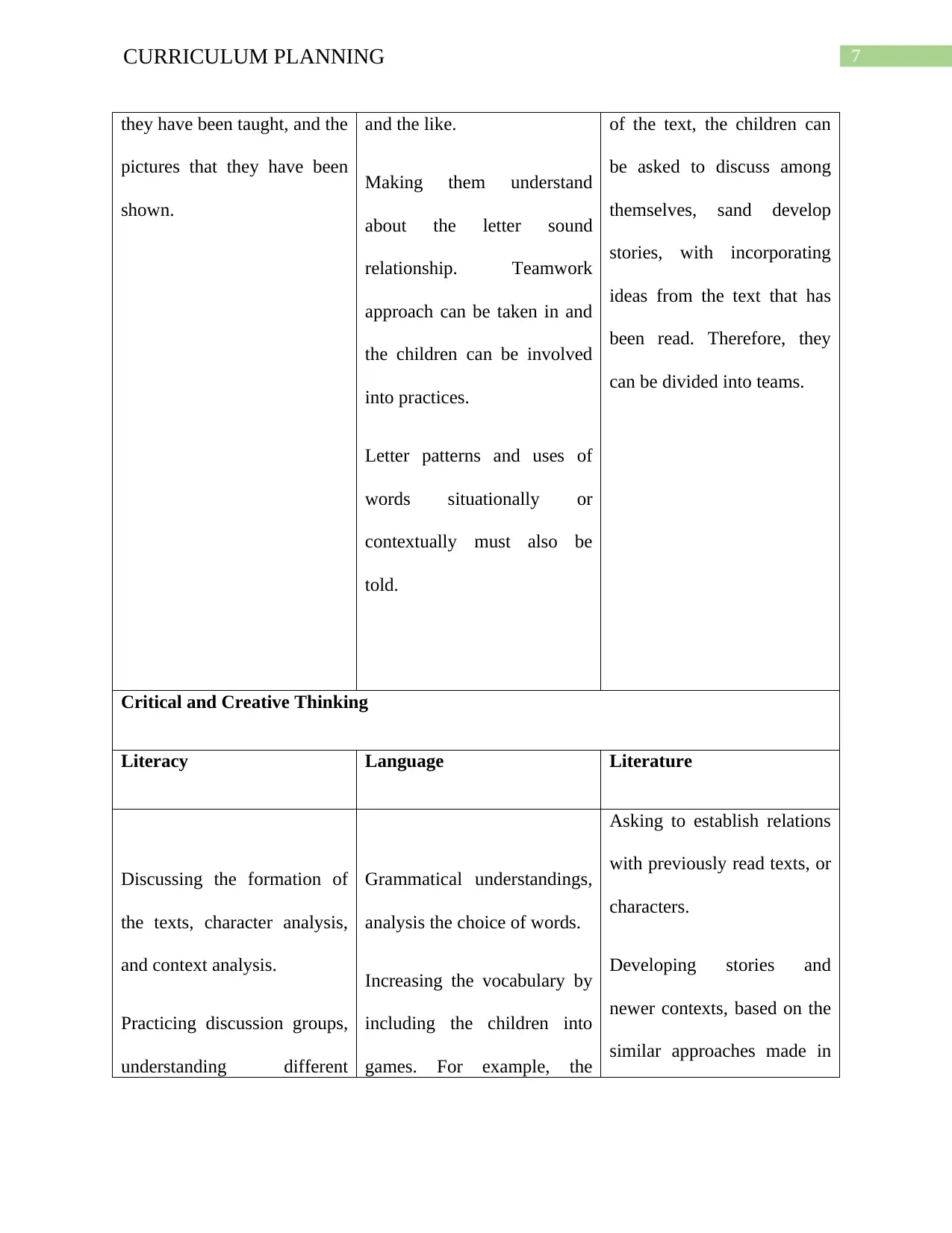
7CURRICULUM PLANNING
they have been taught, and the
pictures that they have been
shown.
and the like.
Making them understand
about the letter sound
relationship. Teamwork
approach can be taken in and
the children can be involved
into practices.
Letter patterns and uses of
words situationally or
contextually must also be
told.
of the text, the children can
be asked to discuss among
themselves, sand develop
stories, with incorporating
ideas from the text that has
been read. Therefore, they
can be divided into teams.
Critical and Creative Thinking
Literacy Language Literature
Discussing the formation of
the texts, character analysis,
and context analysis.
Practicing discussion groups,
understanding different
Grammatical understandings,
analysis the choice of words.
Increasing the vocabulary by
including the children into
games. For example, the
Asking to establish relations
with previously read texts, or
characters.
Developing stories and
newer contexts, based on the
similar approaches made in
they have been taught, and the
pictures that they have been
shown.
and the like.
Making them understand
about the letter sound
relationship. Teamwork
approach can be taken in and
the children can be involved
into practices.
Letter patterns and uses of
words situationally or
contextually must also be
told.
of the text, the children can
be asked to discuss among
themselves, sand develop
stories, with incorporating
ideas from the text that has
been read. Therefore, they
can be divided into teams.
Critical and Creative Thinking
Literacy Language Literature
Discussing the formation of
the texts, character analysis,
and context analysis.
Practicing discussion groups,
understanding different
Grammatical understandings,
analysis the choice of words.
Increasing the vocabulary by
including the children into
games. For example, the
Asking to establish relations
with previously read texts, or
characters.
Developing stories and
newer contexts, based on the
similar approaches made in
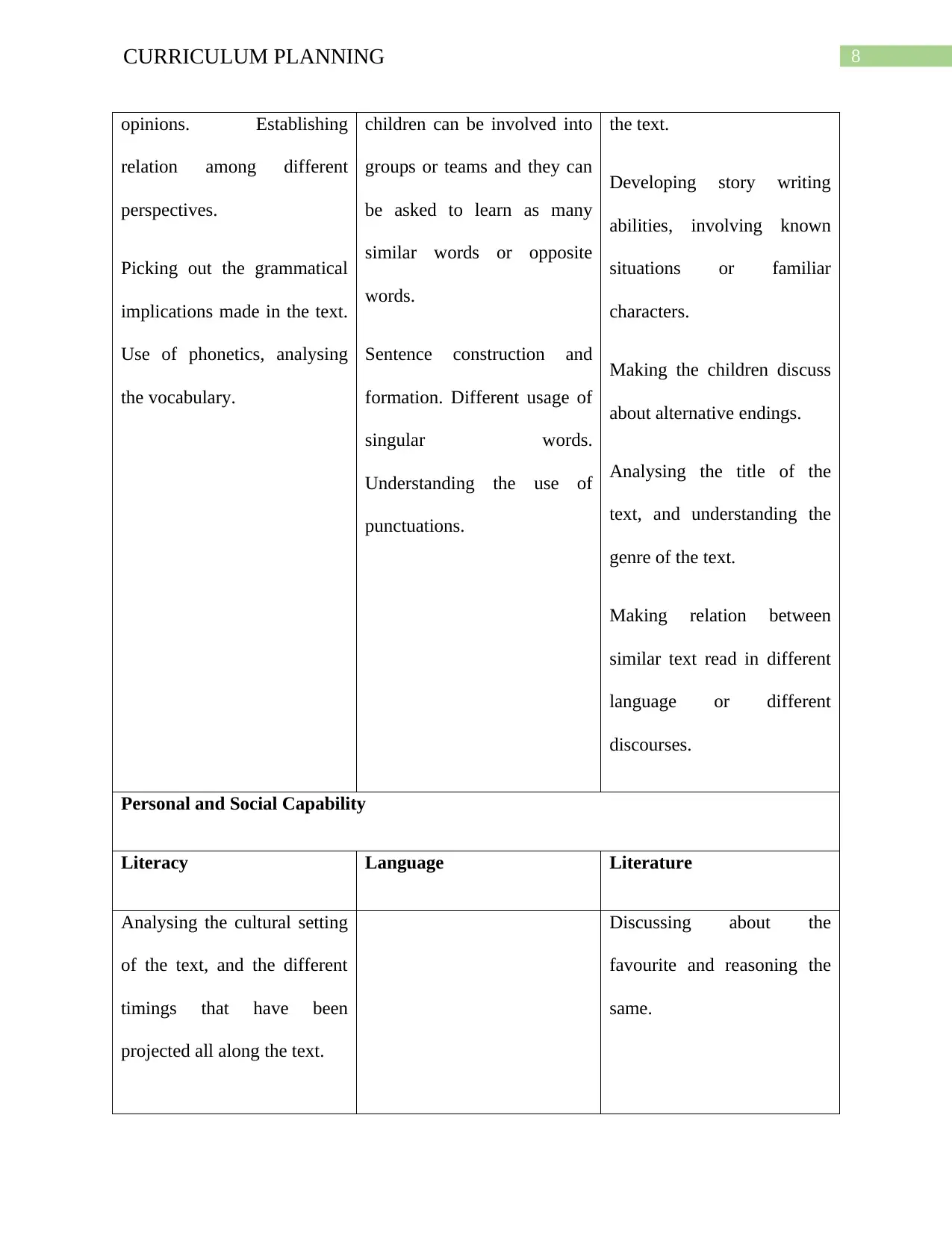
8CURRICULUM PLANNING
opinions. Establishing
relation among different
perspectives.
Picking out the grammatical
implications made in the text.
Use of phonetics, analysing
the vocabulary.
children can be involved into
groups or teams and they can
be asked to learn as many
similar words or opposite
words.
Sentence construction and
formation. Different usage of
singular words.
Understanding the use of
punctuations.
the text.
Developing story writing
abilities, involving known
situations or familiar
characters.
Making the children discuss
about alternative endings.
Analysing the title of the
text, and understanding the
genre of the text.
Making relation between
similar text read in different
language or different
discourses.
Personal and Social Capability
Literacy Language Literature
Analysing the cultural setting
of the text, and the different
timings that have been
projected all along the text.
Discussing about the
favourite and reasoning the
same.
opinions. Establishing
relation among different
perspectives.
Picking out the grammatical
implications made in the text.
Use of phonetics, analysing
the vocabulary.
children can be involved into
groups or teams and they can
be asked to learn as many
similar words or opposite
words.
Sentence construction and
formation. Different usage of
singular words.
Understanding the use of
punctuations.
the text.
Developing story writing
abilities, involving known
situations or familiar
characters.
Making the children discuss
about alternative endings.
Analysing the title of the
text, and understanding the
genre of the text.
Making relation between
similar text read in different
language or different
discourses.
Personal and Social Capability
Literacy Language Literature
Analysing the cultural setting
of the text, and the different
timings that have been
projected all along the text.
Discussing about the
favourite and reasoning the
same.
⊘ This is a preview!⊘
Do you want full access?
Subscribe today to unlock all pages.

Trusted by 1+ million students worldwide
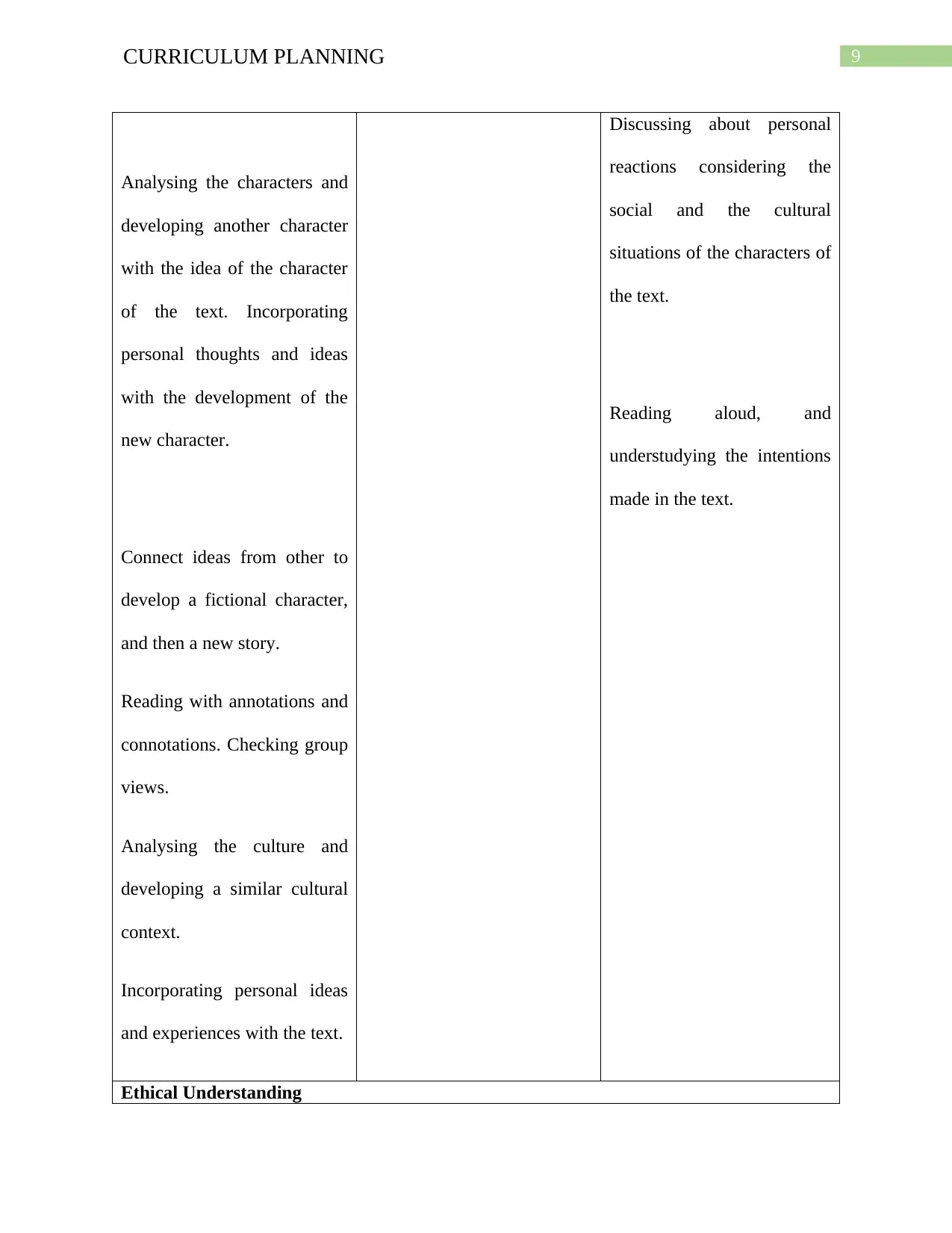
9CURRICULUM PLANNING
Analysing the characters and
developing another character
with the idea of the character
of the text. Incorporating
personal thoughts and ideas
with the development of the
new character.
Connect ideas from other to
develop a fictional character,
and then a new story.
Reading with annotations and
connotations. Checking group
views.
Analysing the culture and
developing a similar cultural
context.
Incorporating personal ideas
and experiences with the text.
Discussing about personal
reactions considering the
social and the cultural
situations of the characters of
the text.
Reading aloud, and
understudying the intentions
made in the text.
Ethical Understanding
Analysing the characters and
developing another character
with the idea of the character
of the text. Incorporating
personal thoughts and ideas
with the development of the
new character.
Connect ideas from other to
develop a fictional character,
and then a new story.
Reading with annotations and
connotations. Checking group
views.
Analysing the culture and
developing a similar cultural
context.
Incorporating personal ideas
and experiences with the text.
Discussing about personal
reactions considering the
social and the cultural
situations of the characters of
the text.
Reading aloud, and
understudying the intentions
made in the text.
Ethical Understanding
Paraphrase This Document
Need a fresh take? Get an instant paraphrase of this document with our AI Paraphraser
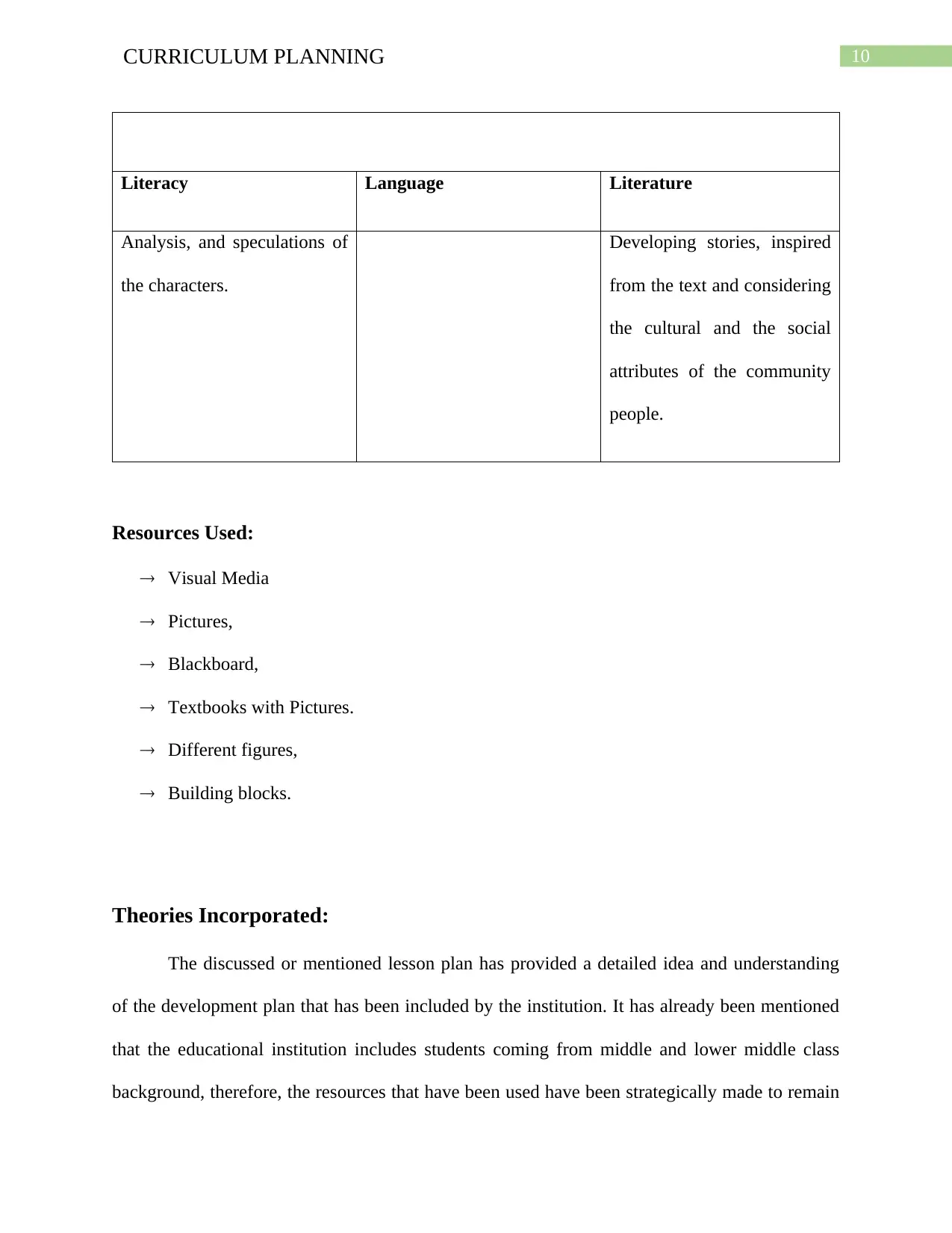
10CURRICULUM PLANNING
Literacy Language Literature
Analysis, and speculations of
the characters.
Developing stories, inspired
from the text and considering
the cultural and the social
attributes of the community
people.
Resources Used:
Visual Media
Pictures,
Blackboard,
Textbooks with Pictures.
Different figures,
Building blocks.
Theories Incorporated:
The discussed or mentioned lesson plan has provided a detailed idea and understanding
of the development plan that has been included by the institution. It has already been mentioned
that the educational institution includes students coming from middle and lower middle class
background, therefore, the resources that have been used have been strategically made to remain
Literacy Language Literature
Analysis, and speculations of
the characters.
Developing stories, inspired
from the text and considering
the cultural and the social
attributes of the community
people.
Resources Used:
Visual Media
Pictures,
Blackboard,
Textbooks with Pictures.
Different figures,
Building blocks.
Theories Incorporated:
The discussed or mentioned lesson plan has provided a detailed idea and understanding
of the development plan that has been included by the institution. It has already been mentioned
that the educational institution includes students coming from middle and lower middle class
background, therefore, the resources that have been used have been strategically made to remain
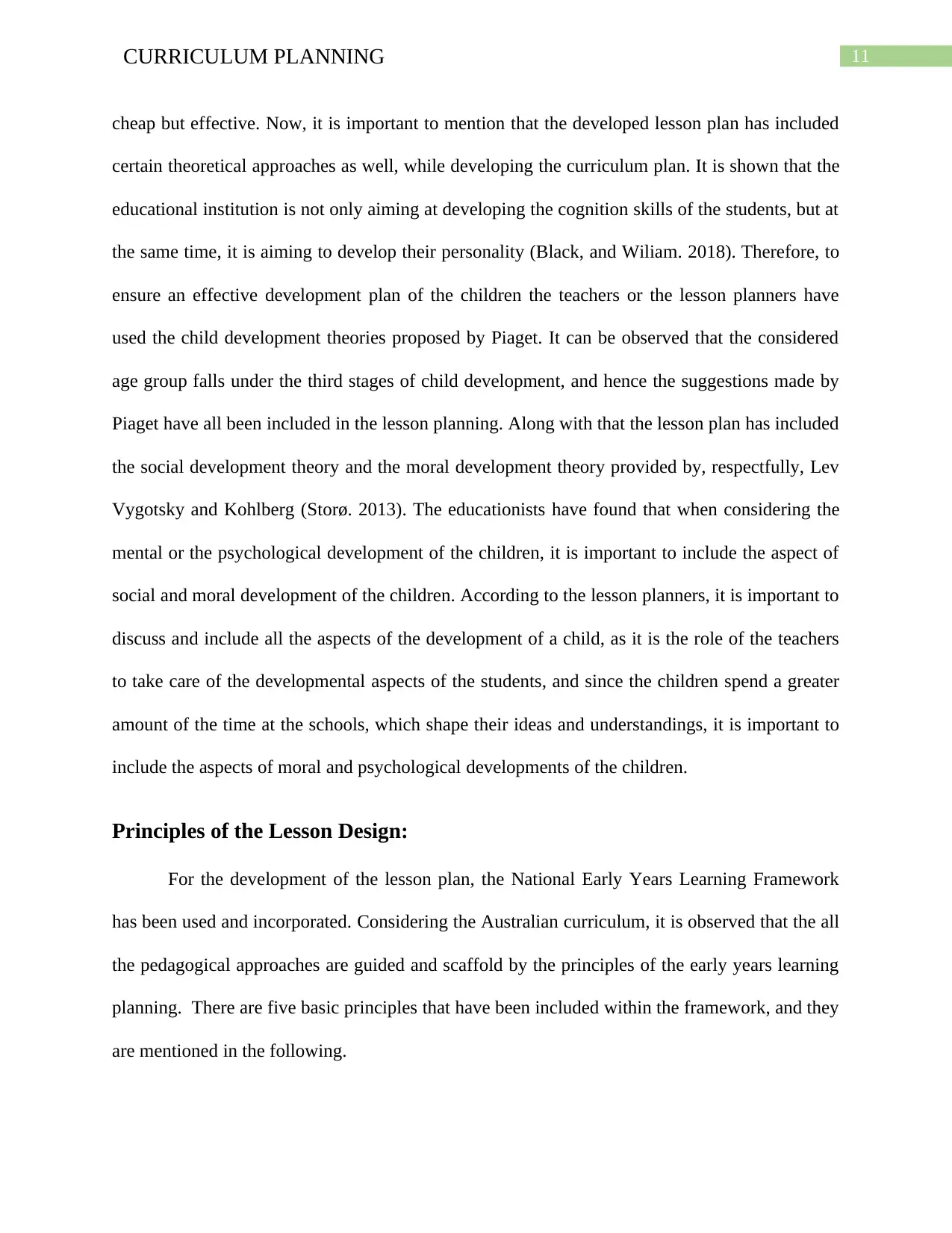
11CURRICULUM PLANNING
cheap but effective. Now, it is important to mention that the developed lesson plan has included
certain theoretical approaches as well, while developing the curriculum plan. It is shown that the
educational institution is not only aiming at developing the cognition skills of the students, but at
the same time, it is aiming to develop their personality (Black, and Wiliam. 2018). Therefore, to
ensure an effective development plan of the children the teachers or the lesson planners have
used the child development theories proposed by Piaget. It can be observed that the considered
age group falls under the third stages of child development, and hence the suggestions made by
Piaget have all been included in the lesson planning. Along with that the lesson plan has included
the social development theory and the moral development theory provided by, respectfully, Lev
Vygotsky and Kohlberg (Storø. 2013). The educationists have found that when considering the
mental or the psychological development of the children, it is important to include the aspect of
social and moral development of the children. According to the lesson planners, it is important to
discuss and include all the aspects of the development of a child, as it is the role of the teachers
to take care of the developmental aspects of the students, and since the children spend a greater
amount of the time at the schools, which shape their ideas and understandings, it is important to
include the aspects of moral and psychological developments of the children.
Principles of the Lesson Design:
For the development of the lesson plan, the National Early Years Learning Framework
has been used and incorporated. Considering the Australian curriculum, it is observed that the all
the pedagogical approaches are guided and scaffold by the principles of the early years learning
planning. There are five basic principles that have been included within the framework, and they
are mentioned in the following.
cheap but effective. Now, it is important to mention that the developed lesson plan has included
certain theoretical approaches as well, while developing the curriculum plan. It is shown that the
educational institution is not only aiming at developing the cognition skills of the students, but at
the same time, it is aiming to develop their personality (Black, and Wiliam. 2018). Therefore, to
ensure an effective development plan of the children the teachers or the lesson planners have
used the child development theories proposed by Piaget. It can be observed that the considered
age group falls under the third stages of child development, and hence the suggestions made by
Piaget have all been included in the lesson planning. Along with that the lesson plan has included
the social development theory and the moral development theory provided by, respectfully, Lev
Vygotsky and Kohlberg (Storø. 2013). The educationists have found that when considering the
mental or the psychological development of the children, it is important to include the aspect of
social and moral development of the children. According to the lesson planners, it is important to
discuss and include all the aspects of the development of a child, as it is the role of the teachers
to take care of the developmental aspects of the students, and since the children spend a greater
amount of the time at the schools, which shape their ideas and understandings, it is important to
include the aspects of moral and psychological developments of the children.
Principles of the Lesson Design:
For the development of the lesson plan, the National Early Years Learning Framework
has been used and incorporated. Considering the Australian curriculum, it is observed that the all
the pedagogical approaches are guided and scaffold by the principles of the early years learning
planning. There are five basic principles that have been included within the framework, and they
are mentioned in the following.
⊘ This is a preview!⊘
Do you want full access?
Subscribe today to unlock all pages.

Trusted by 1+ million students worldwide
1 out of 15
Related Documents
Your All-in-One AI-Powered Toolkit for Academic Success.
+13062052269
info@desklib.com
Available 24*7 on WhatsApp / Email
![[object Object]](/_next/static/media/star-bottom.7253800d.svg)
Unlock your academic potential
Copyright © 2020–2025 A2Z Services. All Rights Reserved. Developed and managed by ZUCOL.





